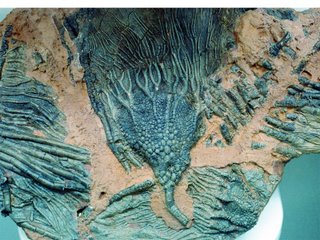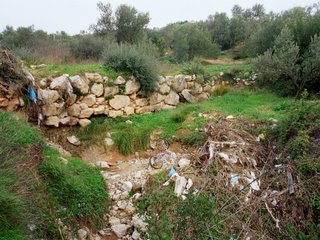We set off on the road out of Nafplio a little after breakfast ceased being served at the Marianna Rooms under the castle and after a short drive around the fortifications of the "Its Kale", or more altaicly Uç Kale we set off east for the Epidaurus area.
A quick word on the Uç Kale whatsit - the words mean three forts or three castles in Turkish and are a reference to the triple fortifications of the hill above Nafpio on which the Xenia and Nafplia Palace now stand.
The video below opens with a view from the hotel, shows some of the Its Kale fortifications including the winged lions which the venetians saw fit to carve into flat surfaces everywhere. It's a little jerky in places, but you get the idea.
The plan was to go out towards Ligourio, have a look around in the Natural History Museum in the town and then to go fossil hunting for ourselves in the area before the theater. If there was time, we would look for the old medieval church which is covered in classical spolia which is meant to be in Ligourio.
On the way, with K driving, we passed a MiniCult sign, in the standard 1:5 side ratio and the brown cultural sign colour. Mycenaean bridges, it said. This was quite a few km from the Mycenaean bridge I know about on the route, although I have often read about there being more thna one bridge no the way to Epidaurus. Well, we did what every self-respecting bronze-age loving sort of guy does and we stopped the car and set off along the foot path for the bridges marked by the signpost.
After a brief walk of about 300m on a footpath worn away in places by recent strong rains we reached a signpost indicating that there are two bridges, one very close, the other an unknown distance away down a continuation of the good footpath. I would not suggest doing the walk between the two bridges during normal daytime hours in the summer, leave it for late afternoon or early morning. I would love to walk the whole route some day linking Epidaurus on the coast to Mycenae via Midea.

Here is K with the bridge's corbelled arch framing her. Corbelling is a vaulting technique whereby a space can be vaulted not by making use of the arch (first discovered and widely implemented in the Hellenistic times) but by positioning each successive block in such a way that although it overhangs the previous, the forces produced do not cause instability as they are sent downwards to the base of the structure. Something like the cantilever effect, I am told. The system was used extensively for the so-called galleries at Tiryns and, of course, in the construtcion of tholos / beehive tombs.
The photo in the trailer post was taken in front of the well known and very photographed mycenaean bridge at Kazarma. I have photos of myself with this bridge from maybe even ten years ago, maybe more. We found the other end of the nice new footpath here, confirming that the second bridge referred to at the first was the one at Kazarma.
I hope some day to be able to get organised enough to put up a photo from every one of my visits to the bridge.
Next up, and really rather happy with our successes in seeing new things in an old neighbourhood, we took a left turning to go find the third of the three bridges which are currently signposted. The signposts lead you up a narrow road which stops abruptly next to a local resident's house. Fortunately this local resident keeps her yard gate open, otherwise there would be no space to do the 3 point turn required if one is to avoid reversing back to the main road. The bridge is close enough to the main road to walk easily rather than to go through the whole three point turn and reversing thing.
We were rather disappointed with K to finally reach the final bridge. The recent heavy rains had brought a whole lot of crap down the hill and what we ended up seeing was less an archaeological site than a tip - complete with what seems to be the mandatory child's bicycle. I am not sure whether this is visible in the photo, but it should be clear in the video.
The video opens with the walk from the car to the first bridge, some looks at the first bridge, the road on the way to the Kazarma bridge, some walking around and into the bridge of Kazarma, complete with some close-up views of the masonry and some little numbered dots that the archaeologists have put on the bridge. From there, we have a drive-by shot of the Kazarma Tholos Tomb - pretty much contemporary with the bridges, or possibly slightly earlier (to judge by the size of the blocks in the masonry). We then have the drive up to the local lady's house and the walk to the third bridge. I know I could have made the editing tighter, but when one is rushed, and has no real natural flair, one sacrifices quality for time - that's what I say to myself to allow me to sleep at night.
Putting the bridges firmly behind us and a little disappointed by the third bridge, we continued on to Ligourio. I had mixed feelings about the Natural History of Ligourio ever since I heard about its opening and especially given the quality of other road-side private museums I have visited.

Collection of shells spelling out the museum's name
Entering, I was pleased to see the number of posters on geologic or ecologic themes, many of which were obviously brought from abroad and translated specifically for the museum. The museum is laid out on one floor, in a number of rooms with most emphasis being placed on marine fossils from the Paleozoic and Mesozoic periods, although some more recent finds from the Pikermi bone beds and from the Rafina area were also present. There was obvious emphasis placed not only on the local fossils (from the Epidaurus area) but also on Moroccan fossils which had been purchased specially for the museum.
The lady told me that photography was allowed and here is a selection of my favourite shots from in the museum:

Crinoids - these frond shaped critters are animals which anchor themselves to the sea floor and filter nutrients and plankton and stuff out of the seawater in order to eat.

An Epidaurian ammonite sawn in half and polished to display the internal structures preserved.


Death assemblages of ammonites, again from the Epidaurus region

A trident-faced trilobite of the Walliserops Trifurcatus species.
The video shows a walk-around of the main parts of the museum. One take, a little rushed.
I bought my very first trilobite from the museum shop for the sum of 10 Euro - not a bad deal I think although I have no idea how much trilobites cost elsewhere.
We had managed to gather no information about the whereabouts of the Epidaurus fossil beds, but we had a pretty good idea of what we were looking for - essentially black round things sticking out of the pinky-red matrix.
We set off from the museum and following a lead found on the net, we circled the nearby hill which we supposed must be the location of the fossil beds. We found nothing. I am not used to not finding what I am looking for, so we went round and round this hill, and we walked into it off the dirt track, but generally had no joy.
I need to have a look at a geological map of the area, slap it onto the computer, then onto the GPS and go back.

The hill we circled may not be the right place to look - but it had a dirt-road so we looked there.
From there we went to Epidaurus on the coast and back to Athens.



1 comment:
what archaelogical bullshit is this?noone is ever likely to read this!you spare your time..
Post a Comment